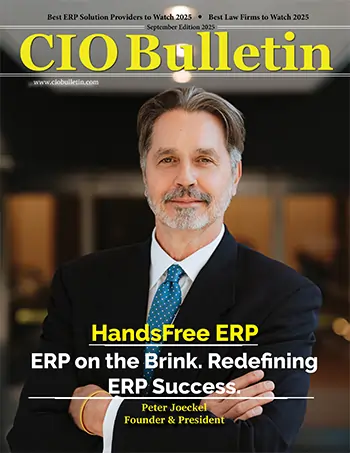Sanjeev Fadnavis, Nitor Infotech CEO: “We have established ourselves as a market leader today by maintaining strict quality standards to deliver excellence.”
Nitor Infotech is a digital enterprise offering world-class solutions and product engineering services specifically for ISVs, enterprises, and tech platform-based service providers. Nitor Infotech’s endeavor to deliver cutting-edge products and solutions is fuelled by modernization and a data-first philosophy. In the rapidly evolving world, we live in; data plays a crucial role in guiding businesses toward success. However, extracting, organizing, and visualizing the vast amount of data that businesses receive can be quite challenging. Fortunately, there is a solution for you: data modeling.
Data modeling is the process of creating a conceptual representation of data structures, relationships, and rules within an organization. It involves identifying and defining the data entities, attributes, and their interconnections.
Once the data gets organized, data visualization presents the modeled data in a visual format for better understanding and analysis.
By creating a blueprint of the data ecosystem, data modeling enhances data integrity, accuracy, and consistency. It serves as a foundation for database design, application development, and data analysis.
Ultimately, data modeling helps organizations gain insights, optimize processes, and leverage data effectively to drive business success.
The Evolution
Data modeling has evolved significantly over the years, reaching key milestones in its progression.
- In the 1960s, hierarchical and network models emerged to help organize the data.
- In the 1970s, relational databases and entity-relationship models revolutionized data management and laid the foundation for modern data modeling.
- By the 1980s, object-oriented data modeling introduced a new way of representing data and relationships in software systems.
- In the 1990s, dimensional modeling emerged, structuring data for efficient analysis and reporting in decision support systems.
- The 2000sintegrated data modeling with XML, facilitating data interchange and standardization. Data warehouses became prominent for storing and accessing large amounts of structured data.
- Today, data modeling encompasses NoSQL and graph databases, enabling advanced analytics and AI applications in the era of big data and cloud computing.
Data modeling includes various types, each offering unique benefits for business growth. Now, let’s delve into this intriguing realm and explore the different data modeling types in detail.
Data Modeling Standards
Data modeling standards can be defined as a set of guidelines and conventions that confirm how data is structured, organized, and represented in a database system. It outlines the rules for creating entities, attributes, relationships, and constraints. These standards serve as a framework for designing, documenting, and maintaining data models for effective data management and system development.
There are 3 types of data modeling standards:
- Conceptual Data Modeling (CDM)
- Logical Data Modeling (LDM)
- Physical Data Modeling (PDM)
The 3 data modeling standards mentioned above provide several benefits. Such as:
- Promotes consistency:Standards help maintain a uniform structure and representation of data. It enables easier understanding and collaboration among stakeholders.
- Enhances data quality:By following standardized guidelines, data modeling reduces errors, redundancies, and inconsistencies. This leads to improved data accuracy and reliability.
- Enables interoperability:Standards facilitate integrating and exchanging data models between different systems and organizations. Thus, ensuring seamless data flow and compatibility.
- Supports scalability and maintenance:Well-defined standards make data models more adaptable to changes.
- Improves communication:Consistent standards enable effective communication between data modelers, developers, and users. Therefore, it eliminates misunderstandings or confusion.
To clarify, data modeling types refer to the different approaches and methodologies used to create data models whereas data models themselves represent the structured representations of information.
Don’t confuse the t Data modeling entails going through these steps:
- Identify Requirements:Understand business needs and define project goals by engaging stakeholders and subject matter experts.
- Conceptual Modeling:Create a high-level model representing entities, relationships, and attributes without technical details.
- Logical Modeling:Develop detailed model mapping entities, attributes, and relationships.
- Normalization:Eliminate redundancy and ensure data integrity through normalization techniques.
- Physical Modeling:Optimize the logical model for a specific DBMS, considering performance and indexing strategies.
- Validation and Iteration:Review and gather feedback on the model, iteratively addressing issues and requirements.
- Documentation:Document the purpose, entities, relationships, and attributes of the data model.
- Implementation:Translate the data model into a physical database schema, tables, and relationships.
Well, along with the process, it’s important to recognize the value of certain tools that are essential for executing it effectively.
Best Practices for Data Modeling
Here are some of the best practices for data modeling:
- Collaboration:Encourage teamwork and knowledge sharing by utilizing collaborative features that enable multiple users to work on the same model simultaneously.
- Version Control:Implement version control mechanisms to track changes and maintain a history of data models for consistency and easy rollback if needed.
- Documentation:Create comprehensive documentation for data models, including assumptions, business rules, and constraints, to enhance understanding and facilitate development and maintenance.
- Regular Review:Continuously review and update data models to align with evolving business requirements. This ensures that they accurately reflect the current state of the data and support ongoing development efforts.
Therefore, as data continues to grow in volume, organizations that prioritize data modeling and business intelligence will be better equipped to make well-informed decisions.
Nitor Infotech’s expertise in data management solutions positions them as a valuable partner for organizations looking to excel in the digital age. By leveraging its knowledge and experience, businesses can confidently embrace scalable data management systems and implement strong data governance practices.
Sanjeev Fadnavis, Chief Executive Officer
“At Nitor Infotech, we believe it’s important to challenge yourself and leverage your unique skill set to make a difference.”








